2-Way Crossover Design / Calculator Help
Use the 2-way Crossover Designer.
Crossovers are used to filter certain frequencies from a driver. A High Pass Filter (HPF) filters out low frequencies - for example, removing bass from a tweeter. A Low Pass Filter (LPF) filters out high frequencies - for example, removing treble from a woofer. Crossovers are necessary to prevent overlap in frequency response from different drivers in a system, and to prevent a driver from producing frequencies it was not designed for. See the Crossover Tutorial & Crossover FAQ for more information.
Typically, lower order crossovers are preferred when possible. The more gradual reduction in the speaker response is less noticeable than the sharp reduction from a higher order crossover, making it more difficult to notice the crossover point. Low order crossovers are also cheaper and easier to make. The issue with low order crossovers is that the reduction in driver response might be so slow that the driver cannot handle some frequencies at the required load.
Note that some crossovers can produce phase shift problems. A second order crossover will shift the phase of each speaker 90 degrees, so that both speakers are 180 degrees out of phase. This means that at the crossover frequency, the two drivers will be moving in opposite directions at the same time. They will cancel each other out and produce a 30db dip in the frequency response at the crossover point. Reversing polarity of one (but not both) of the speakers will limit this dip to +- 3db.
Here are the formulas for 1st, 2nd, 3rd, 4
1st Order Crossovers
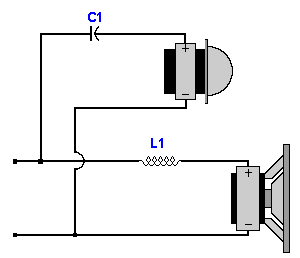
Rh = Driver Impedance of the High Freq Driver in Ohms
Rl = Driver Impedance of the Low Freq Driver in Ohms
f = Crossover Frequency in Hz

| Butterworth | Solen Split | |
|---|---|---|
| cratio1 | .1590 | .1125 |
| lratio1 | .1592 | .2251 |
2nd Order Crossovers
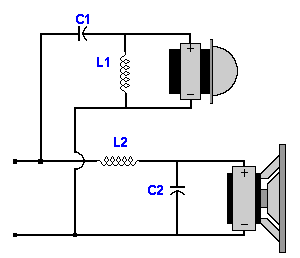
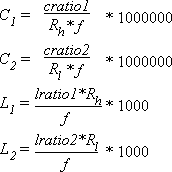
| Linkwitz-Riley | Butterworth | Bessel | Chebychev | |
|---|---|---|---|---|
| cratio1 | .0796 | .1125 | .0912 | .1592 |
| cratio2 | .0796 | .1125 | .0912 | .1592 |
| lratio1 | .3183 | .2251 | .2756 | .1592 |
| lratio2 | .3183 | .2251 | .2756 | .1592 |
3rd Order Crossovers
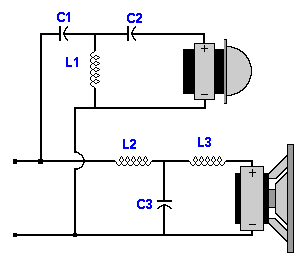
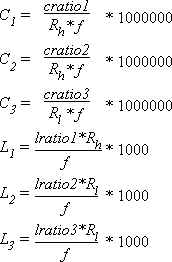
| Butterworth | Bessel | |
|---|---|---|
| cratio1 | .1061 | .0791 |
| cratio2 | .3183 | .3953 |
| cratio3 | .2122 | .1897 |
| lratio1 | .1194 | .1317 |
| lratio2 | .2387 | .3294 |
| lratio3 | .0796 | .0659 |
4th Order Crossovers
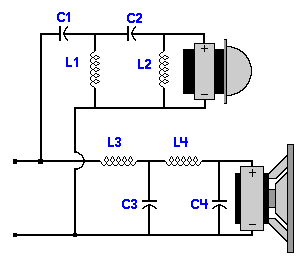
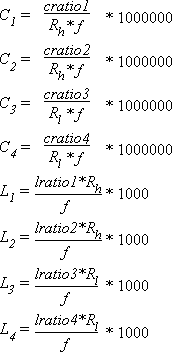
| Linkwitz-Riley | Bessel | Butterworth | |
|---|---|---|---|
| cratio1 | .0844 | .0702 | .1040 |
| cratio2 | .1688 | .0719 | .1470 |
| cratio3 | .2533 | .2336 | .2509 |
| cratio4 | .0563 | .0504 | .0609 |
| lratio1 | .1000 | .0862 | .1009 |
| lratio2 | .4501 | .4983 | .4159 |
| lratio3 | .3000 | .3583 | .2437 |
| lratio4 | .1500 | .1463 | .1723 |
| Legendre | Gaussian | Linear Phase | |
|---|---|---|---|
| cratio1 | .1104 | .0767 | .0741 |
| cratio2 | .1246 | .1491 | .1524 |
| cratio3 | .2365 | .2235 | .2255 |
| cratio4 | .0910 | .0768 | .0632 |
| lratio1 | .1073 | .1116 | .1079 |
| lratio2 | .2783 | .3251 | .3853 |
| lratio3 | .2294 | .3253 | .3285 |
| lratio4 | .2034 | .1674 | .1578 |
4th Order Crossovers
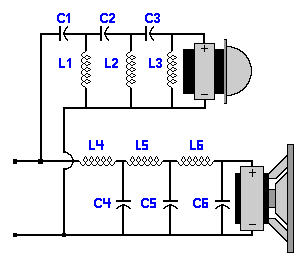

| Linkwitz-Riley | |
|---|---|
| cratio1 | .0884 |
| cratio2 | .1081 |
| cratio3 | .2188 |
| cratio4 | .2947 |
| cratio5 | .1783 |
| cratio6 | .0398 |
| lratio1 | .0859 |
| lratio2 | .1420 |
| lratio3 | .6366 |
| lratio4 | .2865 |
| lratio5 | .2344 |
| lratio6 | .1157 |